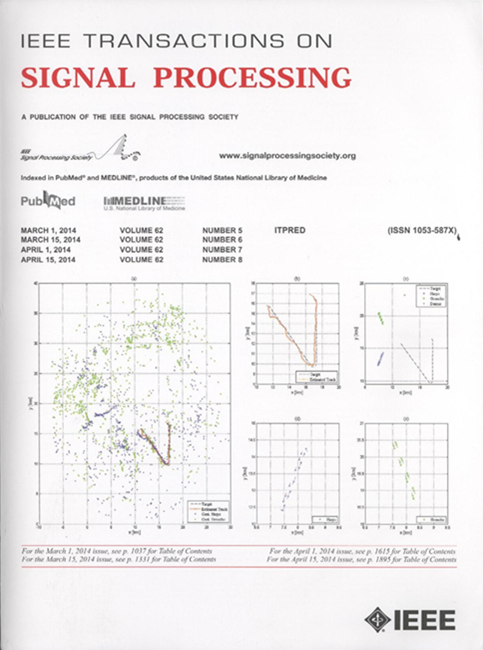频谱受限MIMO雷达的可移动天线增强波束图合成
IF 5.8
2区 工程技术
Q1 ENGINEERING, ELECTRICAL & ELECTRONIC
引用次数: 0
摘要
设计恒模(CM)波形以合成频谱兼容波束是多输入多输出(MIMO)雷达系统的关键。与传统的固定位置天线(FPA)阵列不同,我们提出了一种可移动天线(MA)增强的MIMO雷达,通过引入新的自由度(DoFs)来提高传感性能。这种灵活性允许根据传感要求调整每个天线的位置,并优化传感功率的分配。具体来说,我们共同设计了发射波形和天线位置矢量(APV),以最小化波束图合成的均方误差(MSE),同时遵守了MA阵列位置、频谱兼容性和CM的约束。这导致了具有两个高度耦合变量的非凸二次约束四次规划问题。为了解决这一问题,我们提出了一种精确惩罚积流形(EPPM)方法。首先,基于MA阵列位置和CM的约束特征,构造积正复圆流形(PPC${}^{2}$M)空间,将APV和发射波形投影到该空间;然后,我们采用平滑技术将频谱兼容性约束转化为精确惩罚函数,将问题转化为PPC$^{2}$M空间上的无约束问题。最后,我们提出了一种并行共轭梯度(PCG)方法来优化APV和并行传输波形。仿真结果表明,与现有的基于fpa的方法相比,该方法可将波束方向副瓣降低2.3 dB,将波束方向匹配MSE降低约4 dB。本文章由计算机程序翻译,如有差异,请以英文原文为准。
Movable Antenna Enhanced Beampattern Synthesis for Spectrum Constrained MIMO Radar
Designing Constant Mode (CM) waveforms to synthesize spectrum-compatible beampatterns is crucial for Multiple-Input Multiple-Output (MIMO) radar systems. Unlike traditional Fixed Position Antenna (FPA) arrays, we propose a Movable Antenna (MA) enhanced MIMO radar that improves sensing performance by introducing new degrees of freedom (DoFs). This flexibility allows for the adjustment of each antenna’s position based on sensing requirements and optimizing the allocation of sensing power. Specifically, we co-design the transmit waveform and Antenna Position Vector (APV) to minimize the Mean Squared Error (MSE) of beampattern synthesis while adhering to constraints on MA array position, spectrum compatibility, and CM. This leads to a non-convex Quadratic-Constrained Quartic-Programming (QCQP) problem with two highly coupled variables. To solve this problem, we propose an Exact-Penalized-Product-Manifold (EPPM) method. First, we construct a Product Positivity Complex-Circle Manifold (PPC${}^{2}$ $^{2}$
求助全文
通过发布文献求助,成功后即可免费获取论文全文。
去求助
来源期刊

IEEE Transactions on Signal Processing
工程技术-工程:电子与电气
CiteScore
11.20
自引率
9.30%
发文量
310
审稿时长
3.0 months
期刊介绍:
The IEEE Transactions on Signal Processing covers novel theory, algorithms, performance analyses and applications of techniques for the processing, understanding, learning, retrieval, mining, and extraction of information from signals. The term “signal” includes, among others, audio, video, speech, image, communication, geophysical, sonar, radar, medical and musical signals. Examples of topics of interest include, but are not limited to, information processing and the theory and application of filtering, coding, transmitting, estimating, detecting, analyzing, recognizing, synthesizing, recording, and reproducing signals.
 求助内容:
求助内容: 应助结果提醒方式:
应助结果提醒方式:


